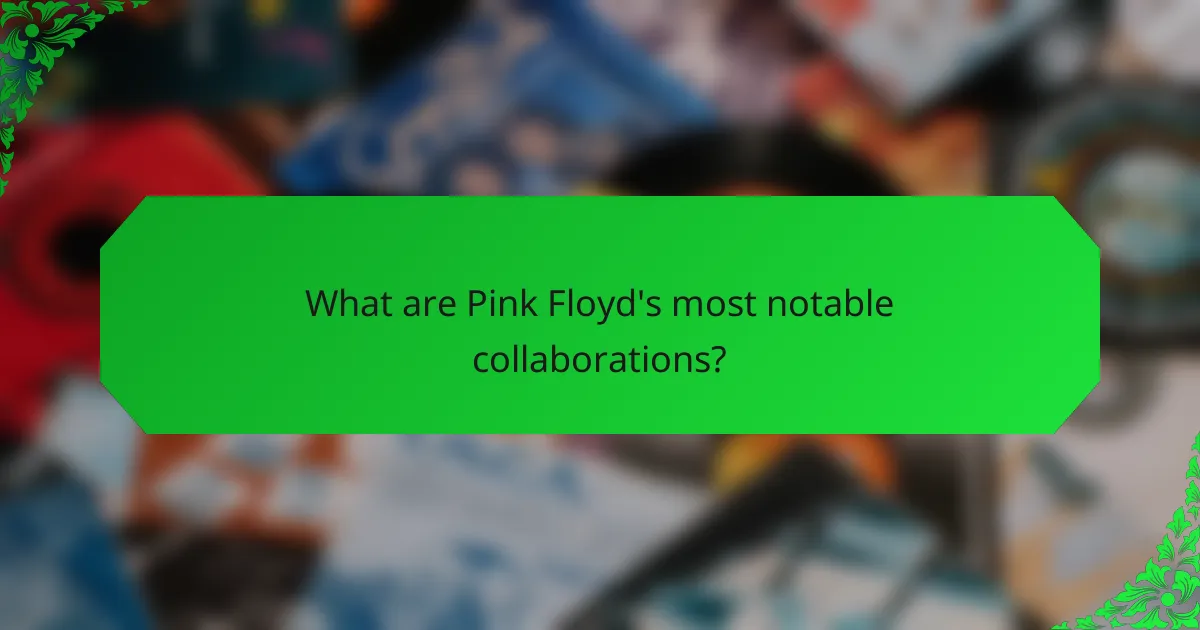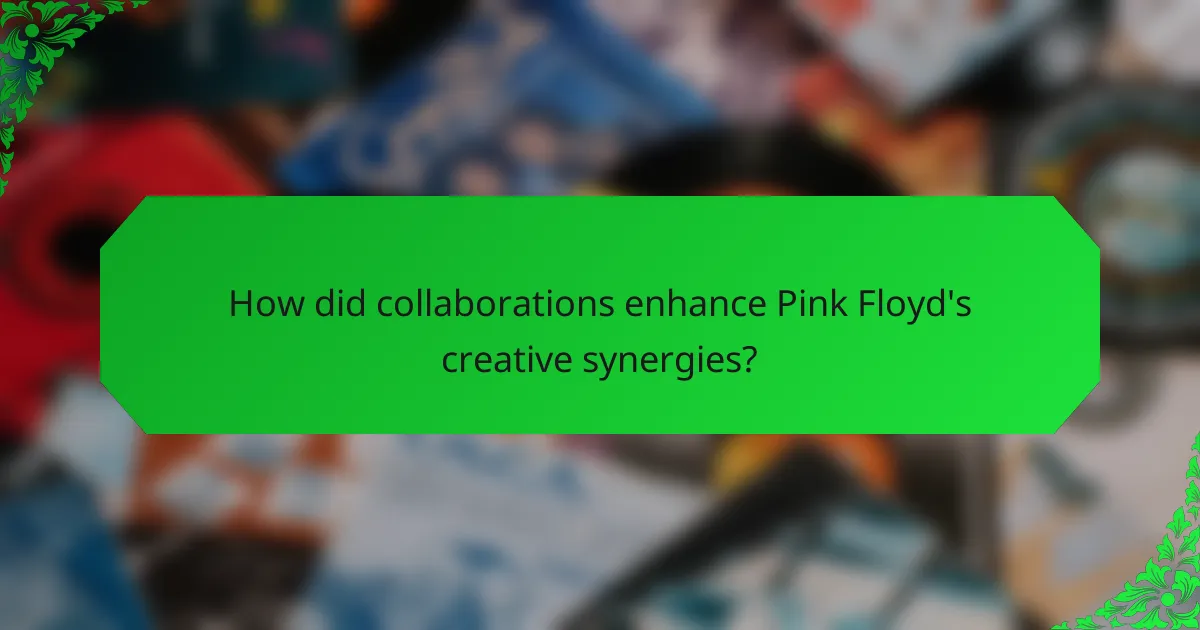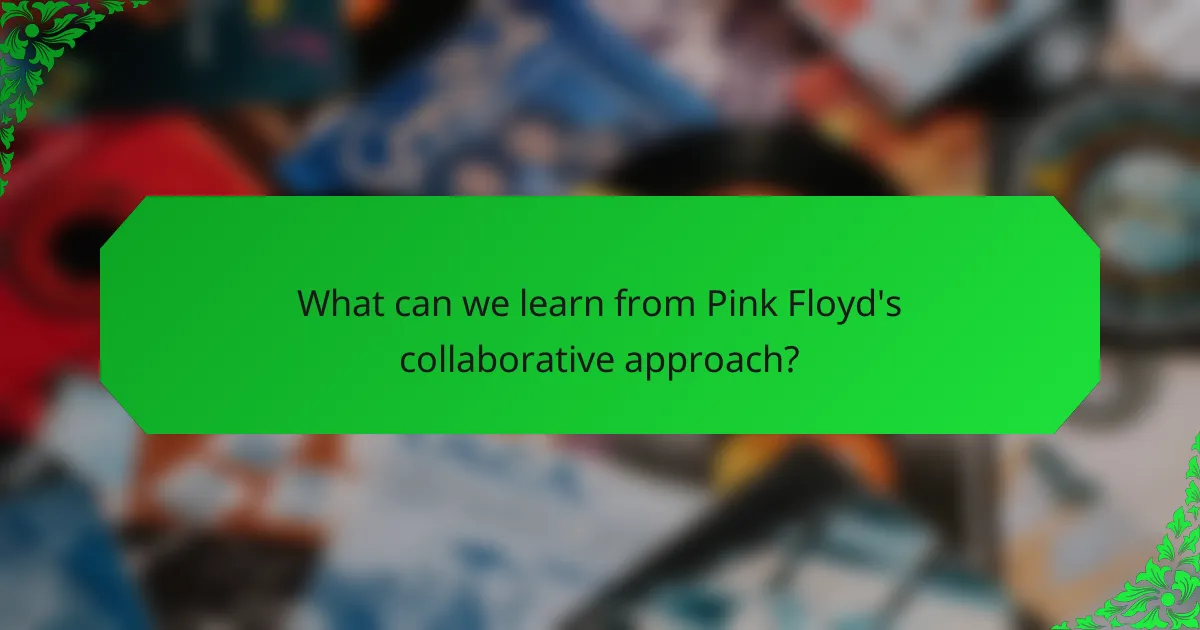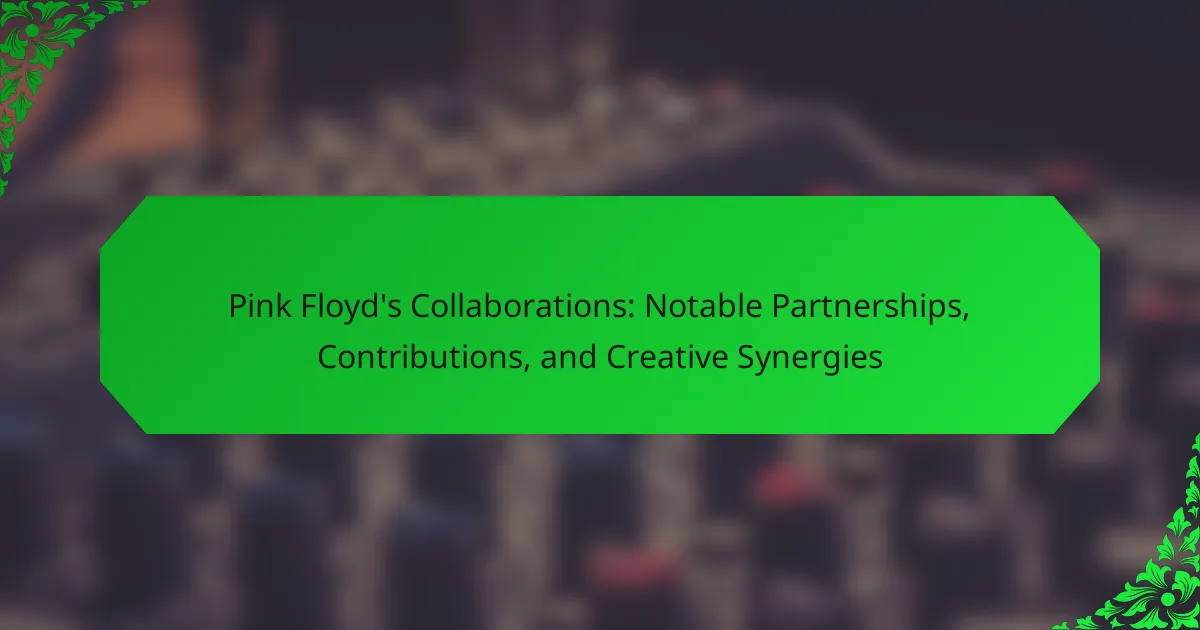Pink Floyd is a renowned rock band known for their innovative sound and influential albums. The article explores notable collaborations that shaped their musical identity, focusing on partnerships with producer Alan Parsons and composer Richard Wright. It highlights how these collaborations contributed to iconic albums like “The Dark Side of the Moon” and “The Wall,” enhancing the band’s creative synergies. The article also discusses the impact of working with other artists and visual creators, emphasizing the importance of diverse creative input in fostering artistic growth and experimentation. Overall, the piece examines how teamwork and collaboration led to Pink Floyd’s groundbreaking results in music.

What are Pink Floyd’s most notable collaborations?
Pink Floyd’s most notable collaborations include their work with producer Alan Parsons and composer Richard Wright. Alan Parsons produced the band’s seminal album “The Dark Side of the Moon.” This collaboration contributed to the album’s innovative sound and commercial success. Richard Wright, a founding member, co-wrote many of the band’s iconic tracks. His contributions included keyboard arrangements and vocals that defined Pink Floyd’s musical identity. Additionally, they collaborated with artists like Bob Ezrin on “The Wall.” This partnership helped shape the album’s theatrical presentation and narrative depth.
Who are the key artists and producers that collaborated with Pink Floyd?
Key artists and producers that collaborated with Pink Floyd include Roger Waters, David Gilmour, and Richard Wright. Roger Waters was a primary lyricist and conceptual force behind many albums. David Gilmour contributed guitar work and vocals, shaping the band’s sound. Richard Wright played keyboards and provided harmonies, enhancing the band’s musical texture. Other notable collaborators include producer Alan Parsons, who worked on “The Dark Side of the Moon.” Additionally, producer Bob Ezrin was instrumental in the creation of “The Wall.” Each of these individuals played a critical role in defining Pink Floyd’s distinctive style and success.
What contributions did each collaborator bring to Pink Floyd’s music?
Syd Barrett contributed innovative songwriting and guitar work, shaping Pink Floyd’s early sound. His whimsical lyrics and unique guitar techniques defined their debut album, “The Piper at the Gates of Dawn.” Roger Waters brought profound lyrical depth and conceptual frameworks. He was instrumental in creating albums like “The Wall” and “Animals,” focusing on themes of isolation and societal critique. David Gilmour added emotive guitar solos and vocal harmonies, enhancing the band’s musical complexity. His contributions are particularly evident in tracks like “Comfortably Numb.” Richard Wright provided atmospheric keyboard textures and vocal contributions, enriching the band’s soundscapes. His work on songs like “The Great Gig in the Sky” showcases his talent. Nick Mason, as the drummer, established the rhythmic foundation. His drumming style was integral to the band’s progressive rock sound. Each collaborator’s contributions were crucial in developing Pink Floyd’s iconic musical identity.
How did these collaborations influence Pink Floyd’s sound and style?
Collaborations significantly influenced Pink Floyd’s sound and style, adding depth and complexity. Notable partnerships with artists like Syd Barrett shaped their early psychedelic sound. The influence of producer Alan Parsons introduced innovative recording techniques, enhancing their sonic landscape. Collaborations with orchestras and other musicians expanded their musical arrangements and textures. These partnerships allowed for experimentation with various genres, including progressive rock and electronic music. The contributions of guest musicians on albums like “The Wall” added unique elements to their compositions. Overall, these collaborations enriched Pink Floyd’s artistic expression and solidified their legacy in music history.
What are the most significant albums that feature collaborations?
The most significant albums that feature collaborations include “The Wall” by Pink Floyd. Released in 1979, it is a rock opera that showcases contributions from various artists. Notably, it features the song “Another Brick in the Wall, Part 2,” which includes a children’s choir. Another significant album is “The Final Cut,” also by Pink Floyd, released in 1983. This album features contributions from various musicians, including Roger Waters and David Gilmour. “Wish You Were Here,” released in 1975, includes collaborations with other artists and pays tribute to former member Syd Barrett. These albums highlight the collaborative efforts that shaped Pink Floyd’s sound and legacy.
Which tracks on these albums highlight collaborative efforts?
The tracks that highlight collaborative efforts on Pink Floyd’s albums include “Another Brick in the Wall, Part 2” and “Comfortably Numb.” “Another Brick in the Wall, Part 2” features contributions from the children’s choir, showcasing a unique partnership. “Comfortably Numb” is noted for the collaboration between David Gilmour and Roger Waters in songwriting and guitar work. These tracks exemplify the band’s ability to blend individual talents into cohesive musical pieces.
How did the collaborative process shape the final outcomes of these albums?
The collaborative process significantly shaped the final outcomes of Pink Floyd’s albums. Each member contributed unique skills and perspectives. For instance, Roger Waters brought lyrical depth and conceptual ideas. David Gilmour added melodic guitar work and vocal harmonies. Richard Wright contributed atmospheric keyboards and arrangements. Nick Mason provided rhythmic foundations and creative input.
This synergy led to innovative soundscapes and cohesive themes across their albums. The collaborative environment fostered experimentation, resulting in groundbreaking works like “The Dark Side of the Moon.” This album, produced through collective efforts, achieved both commercial success and critical acclaim. The interplay of different musical influences and ideas defined their signature sound.
Overall, collaboration was integral to Pink Floyd’s artistic evolution and the distinctiveness of their albums.

How did collaborations enhance Pink Floyd’s creative synergies?
Collaborations enhanced Pink Floyd’s creative synergies by introducing diverse influences and innovative ideas. Working with producers like Alan Parsons brought technical expertise that refined their sound. Collaborations with other artists, such as David Bowie, expanded their musical horizons. These partnerships encouraged experimentation with different genres and styles. The band’s collaboration with visual artists, like Storm Thorgerson, integrated striking imagery into their work. This synergy between music and visuals created a cohesive artistic identity. Overall, collaborations fostered a dynamic creative environment that pushed boundaries and led to iconic albums.
What themes emerged from Pink Floyd’s collaborative works?
Themes that emerged from Pink Floyd’s collaborative works include existentialism, mental health, and societal critique. The band’s collaborations often explored the human condition and the struggles of existence. For instance, the album “The Wall” addresses themes of isolation and alienation. Collaborations with artists like Roger Waters and David Gilmour emphasized personal and collective experiences. Their work also critiques authority and societal norms, evident in songs like “Another Brick in the Wall.” The use of visual arts in their projects further enriched these themes, creating a multi-dimensional narrative. Overall, Pink Floyd’s collaborations reflect deep philosophical inquiries and emotional depth.
How did these themes reflect the band’s evolution over time?
The themes in Pink Floyd’s music reflect the band’s evolution through their exploration of complex concepts and emotional depth. Initially, their work focused on psychedelic experiences and social commentary. As time progressed, their themes evolved to include existentialism and personal struggles. The transition from “The Piper at the Gates of Dawn” to “The Dark Side of the Moon” illustrates this shift. “The Dark Side of the Moon” tackled issues like mental health and the pressures of fame. This thematic evolution mirrored the band’s own experiences and growth as artists. Collaborations with other musicians further enriched these themes, adding layers of complexity. Over time, the band’s sound became more polished, reflecting their artistic maturity. Each album marked a distinct phase in their creative journey, showcasing their ability to adapt and innovate.
What unique artistic visions were realized through these partnerships?
Pink Floyd’s partnerships realized unique artistic visions through innovative soundscapes and visual artistry. Collaborations with artists like Storm Thorgerson led to iconic album covers, merging music with visual storytelling. The band’s work with film director Alan Parker for “The Wall” integrated cinematic elements into their music. Collaborations with other musicians, such as David Bowie, expanded their musical boundaries and influenced genre blending. The synergy with producer Bob Ezrin resulted in a polished sound that enhanced their conceptual themes. Each partnership contributed distinct elements, enriching Pink Floyd’s overall artistic expression.
How did collaborations impact Pink Floyd’s live performances?
Collaborations significantly enhanced Pink Floyd’s live performances. These partnerships brought innovative visual elements and unique soundscapes to their shows. Collaborators like designer Storm Thorgerson contributed iconic album art and stage designs. The use of advanced technology in lighting and sound was influenced by their collaborations. Notable performances, such as “The Wall,” featured elaborate theatrical elements from outside artists. Collaborations also allowed for diverse musical influences, enriching their live renditions. The integration of different artistic visions created a multi-sensory experience for audiences. Overall, these collaborations transformed Pink Floyd’s concerts into groundbreaking events in rock history.
What role did guest musicians play in live shows?
Guest musicians played a significant role in Pink Floyd’s live shows. They contributed additional layers of sound and complexity to the performances. For example, saxophonist Dick Parry enhanced the band’s sound during iconic tracks like “Money” and “Shine On You Crazy Diamond.” Guest musicians also provided unique instrumental capabilities that the core band members could not replicate. Their involvement often created a richer auditory experience for the audience. Collaborations with artists like Bob Geldof and Van Morrison added diverse musical influences. These partnerships allowed for spontaneous creativity during performances. Overall, guest musicians were crucial in elevating the live experience of Pink Floyd’s concerts.
How did these collaborations enhance the audience’s experience?
Collaborations enhanced the audience’s experience by introducing diverse musical elements and innovative soundscapes. These partnerships allowed Pink Floyd to experiment with various genres and styles. Collaborators like David Bowie and Bob Geldof brought unique influences that enriched the band’s sound. Additionally, the integration of visual artists in their projects created immersive experiences during performances. The collaboration with filmmaker Alan Parker for “The Wall” added a cinematic dimension to their music. This synergy between music and visuals captivated audiences, making live shows memorable. Overall, these collaborations expanded the artistic boundaries of Pink Floyd, deepening audience engagement and appreciation.

What can we learn from Pink Floyd’s collaborative approach?
Pink Floyd’s collaborative approach emphasizes the importance of diverse creative input. Each member contributed unique musical skills and perspectives. This synergy led to innovative soundscapes and profound lyrical themes. For example, Roger Waters’ conceptual vision complemented David Gilmour’s melodic guitar work. Their collaboration resulted in iconic albums like “The Dark Side of the Moon.” The band’s ability to blend individual talents fostered artistic growth. This approach showcases how teamwork can enhance creativity and lead to groundbreaking results.
What best practices can new artists adopt from Pink Floyd’s collaborations?
New artists can adopt several best practices from Pink Floyd’s collaborations. First, they should prioritize artistic experimentation. Pink Floyd often explored diverse genres and sounds, pushing creative boundaries. Second, collaboration with other artists can enhance creativity. The band worked with various musicians and producers, enriching their music. Third, maintaining a strong vision is crucial. Pink Floyd had a distinct artistic direction that guided their collaborations. Fourth, embracing technology can lead to innovative results. They utilized advanced recording techniques and equipment. Lastly, fostering a collaborative environment encourages open communication. This approach can lead to unique artistic outcomes. These practices reflect Pink Floyd’s successful collaborative efforts in music.
How can collaboration foster creativity in music production?
Collaboration can significantly foster creativity in music production by bringing diverse perspectives together. When artists collaborate, they combine their unique skills and influences. This blending often results in innovative sounds and ideas. Collaborators can challenge each other’s thinking and push creative boundaries. For example, Pink Floyd’s collaboration with producer Alan Parsons led to groundbreaking production techniques. Their partnership resulted in the iconic sound of “The Dark Side of the Moon.” Such collaborations can lead to experimentation with new genres and styles. Ultimately, collaboration enhances the creative process and leads to richer musical outcomes.
What challenges did Pink Floyd face in their collaborations?
Pink Floyd faced several challenges in their collaborations. Creative differences often emerged among band members during the songwriting process. Tensions were heightened by differing artistic visions. The pressure of commercial success also impacted their collaborative efforts. External collaborations sometimes led to conflicts over creative control. Additionally, personal issues, such as Roger Waters’ departure, strained relationships within the band. These challenges influenced the dynamics of their partnerships. Ultimately, such difficulties shaped the band’s evolving sound and direction.
How can overcoming these challenges lead to better partnerships?
Overcoming challenges in collaborations can lead to better partnerships by fostering trust and communication. When obstacles are addressed, partners learn to navigate conflicts effectively. This process enhances mutual understanding and respect. Improved communication reduces misunderstandings and aligns goals. Collaborative problem-solving strengthens the partnership’s foundation. As partners face challenges together, they build resilience. This resilience often translates into more innovative and creative outcomes. Historical examples show that successful collaboration, despite challenges, often leads to iconic works.
Pink Floyd is the main entity explored in this article, focusing on their notable collaborations with key artists and producers. The article details significant partnerships, such as those with Alan Parsons and Richard Wright, highlighting their contributions to iconic albums like “The Dark Side of the Moon” and “The Wall.” It examines how these collaborations influenced Pink Floyd’s sound, thematic evolution, and live performances, while also addressing the challenges faced during their creative processes. Overall, the article underscores the importance of collaboration in shaping the band’s musical identity and legacy.
